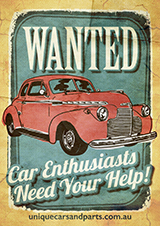The Stutz Bearcat
When the
automobile industry was in its infancy most manufacturers generally identified their different models with a letter or a number. The most common practice with numbers was generally to tie in with the horsepower rating of the car. It was a straightforward business then, but with high stakes and a lot of dismal failures. In the years before World War 1 one of the first companies to use a special name for a particular model was
Stutz, and arguably the best known model from the marque, perhaps because it was given a name, the “Bearcat”. Only a part of
Harry Stutz's cars were Bearcat models; yet nearly a century later this model name is the best remembered. The
Stutz Bearcat was a fine sports car, with lots of flash for its day, and the name Bearcat summed it all up beautifully. The name was carried into the 1920s on a modified Stutz roadster.
The Jordan Playboy
In the mid-Twenties the Jordan was quite an ordinary car. Jordan Motor Car Company of Cleveland built very little of the car in their own shops; instead they purchased all the major sub-assemblies from outside suppliers and simply assembled the cars. This was a common practice in the early years and was also fairly common in Britain, but it seldom resulted in the best products – although it should not be confused with the CKD (Complete Knoock Down) kits sent to Australia for assembly. What Jordan did have going for it was its President, Ned Jordan, who has been credited with outstanding ability for merchandising. He named the sport roadster the Playboy and wrote ads that were classics in their time. His best-remembered ad for the Playboy was "Somewhere West of Laramie. . . ," which sold the fun of owning a Jordan Playboy rather than just the nuts and bolts. Almost immediately the Playboy name caught on; it proved to the industry that it had been missing a good bet. But the success of the Playboy wasn't enough to keep the company afloat very long after the 1929 stock-market crash and Jordan gave up in 1931.
The Kissel White Eagle Speedster
Another well-known American sports car (roadster) was the Kissel, built in Hartford, Wisconsin, USA. Kissel's most famous model, although they built sedans and coupes, was the White Eagle Speedster. As with Stutz and Jordan the name did a great deal to give romance to the car in the motoring public's eyes. In these earlier days the model name did not appear anywhere on the car but merely showed up in the printed ads or in the beautifully prepared sales catalogues. It wasn't until the late 1930s that the practice of hanging model or series names on the cars came into general use. When it did, though, most of the manufacturers started to get carried away.
Standard or De Luxe
An interesting marketing concept got its start during the depression years 1930 to 1934: in the low-price field a Standard and a De Luxe model were offered. Both series were basically the same car, but where they differed was that the De Luxe series usually had twin horns, two inside sun visors, dual tail-lights and two independently operated windshield wipers. To keep the price down the maker gave the Standard series only one of these "accessories." The Standard also had a cheaper grade of interior trim and usually a bit less bright trim on the outside of the car, such as a painted windshield frame rather than chrome, which was reserved for the De Luxe series. This marketing strategy gave the dealers a price-leader for advertising and fleet sales - but the average buyer was usually upgraded into the De Luxe model. This system worked very well, and by the late 1930s the low-priced three (
Ford,
Chevrolet and
Plymouth) began to put De Luxe in script or block lettering on each side of the hood of their premium models. Obviously, for the poor guy who couldn't come up with the extra cash for a De Luxe model, it would have been doing him a disservice to brand his nice, new car with the degrading name Standard, so the plain ones were just called Ford or Plymouth.
The Super De Luxe
This system for the low-priced cars worked so well that in 1941 the manufacturers took it one step farther and came out with a third, even fancier, series still based on the Standard chassis. This new top series became either the Super De Luxe or the Special De Luxe. Of course this downgraded the De Luxe series to a less than top-of-the-line rank. The American public lapped it up and sales boomed in 1941. Pearl Harbor brought everything to a screeching halt on December 7, 1941 and the industry started to convert to war production, but this little game was to find a new level in the 1960s. After the war was over, the car manufacturers got back into production with basically the same 1942 models they had been building when they closed down. After about three years of a wild seller's market while the pent-up urge to buy new Cars was being satisfied, all-new post-war models began to come off the assembly lines from the Big Three. Several of the independents, such as Studebaker and Kaiser-Frazer, had come out a year or two earlier with all-new models. And as all these post-war cars went on sale, the series naming game in the industry really got into high gear.
|
The Stutz Bearcat - perhaps the first car to do away with numbers and carry its own individual name. |
|
Ned Jordan was a brilliant marketer, and the Jordan Playboy enjoyed success more because of its name that the quality or reliability of the car. |
The Bel Air, Catalina and Riviera
The popular "hardtop convertible" coupes introduced by the
General Motors divisions in 1949 each had an exotic name to help entice buyers. Chevrolet came up with the Bel Air,
Pontiac the Catalina and
Buick the
Riviera; these were some of the first to pick names of places.
Olds chose Holiday and
Cadillac turned to the carriage trade for the name Coupe de Ville. No sooner had these models hit the highways than the rest of the Detroit copywriters started a concentrated hunt through world atlases and dictionaries in search of names of other faraway places to further excite the buyers and, of course, to compete with
General Motors. It mattered not that most of the people who bought these cars probably hadn't the foggiest notion where their cars' names came from.
Monaco, Monte Carlo, Biarritz, Calais, Capri and Lido
From Europe we have Monaco, Monte Carlo, Biarritz, Calais, Capri and Lido, to name but a few. If you'd like to head for the tropics, the industry has offered Caribbean, Panama, Montego, Nassau and Bermuda. The names of posh resorts in the continental U.S. included Saratoga, Greenbrier, Newport, Biscayne and Southampton. And when the copywriters began to trip over each other, they turned to the best U.S. suburbs they could think of, using Mainline (Philadelphia), Cranbrook, Belvedere and Malibu - plus a few spots which may have seen better days, like Hollywood and Pasadena.
Then there was the use of “titles”, which included President, State President, Statesman and Diplomat. Believe it or not, there was even a Dictator, which lasted until a year before the most infamous dictator of all time marched into Poland in 1939. And it didn’t stop there, with marketing departments turning the clock back to Roman times, coming up with names like Patrician and Centurion. But there was one title that, to our mind, was always a bit of a back hander. It was used in Australia and the USA. And that was the “Executive”. Not something we would be particularly proud of, but at least the auto makers stopped there, and we didn’t get the “Accountant”, or “Bookkeeper”.
Imperial, Windsor and Royal
Royalty was generously used in the naming game, too, with such names as Imperial, Windsor, Royal, Royale, Crown, Coronet and White Prince. And if a car needed a sporting image, you could use a famous race track, such as Monza, Sebring, Le Mans and Daytona. Then there was the se of character names, popular with Japanese makers as well as those from the USA. Names such as the Scamp, Rogue and Rebel all had anti-social connotations, and perhaps tried to reflect a level of individuality. There were names that reflected travel, such as Nomad, Vagabond or Commuter, and other names with an almost military theme, such as Viking, Corsair and Commando. And of course there were some misses, particularly when Spanish names were used. We all know the “Pajero” translates roughly as “Wanker”, but did you know the popular “Matador” moniker has its literal translation as one who slaughters. Animals and birds have always been a good source for names. Horses, cats and birds lead this list, with a few other stray beasts like Kangaroo and Cobra thrown in. There were also a few unfriendly insects, such as Hudson's Hornet, Wasp and Super Wasp.
As for numerical names, some did remain. Car makers always liked to remind us if their model was fitted with an 8 cylinder engine, so there was the Greater 8, Straight 8, Advanced Twin Ignition 8, Eight-in-Line and others. There were numbers used to reference the top speed, such as the Jaguar XK-120, and even when referring to the length of the car (in inches), such as the Electra 225. Below is a comprehensive list of car monikers, but by no means do we claim that it names everything. Hopefully, you will find your classic cars name listed, and find where the name was derived from enlightening.



